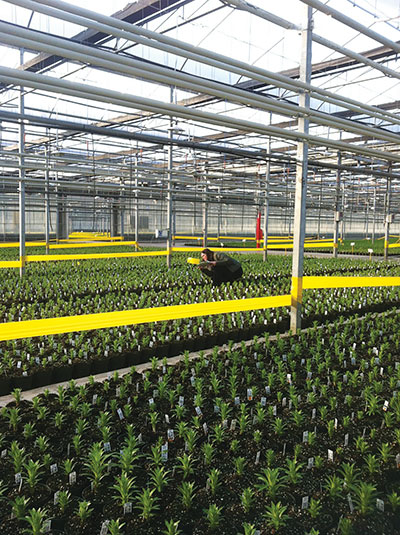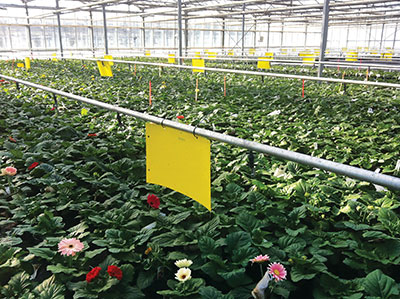
It doesn’t matter what you are growing or what type of IPM system you
are implementing in your operation – mass trapping can play an important
role.
It doesn’t matter what you are growing or what type of IPM system you are implementing in your operation – mass trapping can play an important role.
 |
|
The use of mass trapping as an IPM strategy has been present for decades. However, it has gained in popularity as many growers have moved from chemically based to biologically based IPM systems.
Mass trapping can play an effective role in chemically based IPM programs, allowing for additional opportunities to remove unwanted pests. However, it has really proven its worth in biologically based programs that are focused on the use of predatory mites as the mainstay for control.
There are several products that can be used to achieve this goal and deciding what product or mix of products is best for you is something specific to each operation.
Sticky tape has been a staple for years and can be very effective. However, we must be clear on its strengths and weaknesses.
KEEP TAPE TAUT TO MAXIMIZE SURFACE AREA EXPOSURE
It can be difficult to apply, as the rolls can be heavy and awkward. I have seen many greenhouses minimize this situation by rigging up devices to help with the application. If the tape is not applied correctly it will lead to twisting and drooping, reducing the surface area.
Tape is usually used only as a post application, therefore limiting its effectiveness within the crop itself.
The post row application can be very effective in stopping the migration of pests from one house to another. There are many tapes on the market but quality is key! A good general rule of thumb I like to use is that if the tape appears almost “see through” when the sun is shinning it is a low quality tape.
Sticky cards and sticky traps (large cards) are in my opinion the most versatile and effective use of mass trapping. They can be implemented in so many different ways, allowing growers to make the best decision to fit their needs.
This is not just a case of fitting the application into the structure of the greenhouse; it has to fit the production system as well. There are such a wide variety of crops grown, each with specific needs in the greenhouse system.
CARDS OFFER FLEXIBILITY WITH MASS TRAPPING SYSTEMS
Using cards offers growers the flexibility to fit mass trapping into their current IPM program, or open an opportunity to move from a less effective system to a more comprehensive one.
 |
|
| Many growers are enjoying success with mass trapping cards and tape. PHOTOS COURTESY koppert canada
|
Cards also allow for the flexibility to implement mass trapping within the crop itself. Cards can be placed on stakes or wires and can be placed where the need is highest. Often, part of the IPM system is to implement extra traps in crops that are of specific concern like verbena, ipomoea, etc.
Over the years I have done several tests comparing the use of cards to quality tape. In most situations, both can be just as effective in the removal of many pests.
However, when it comes to thrips, the use of high quality sticky cards has proven to be more effective than even quality tape. Since thrips seems to be the number one problem for most growers, I believe the initial strategy should be to look for an opportunity to implement cards.
I have seen several operations that have made the decision to replace even the post applications that were usually relegated to tapes with a hanging card system.
A wire (usually shade curtain wire) is applied to the posts with a simple self-tapping screw with washer. This wire stays up for years and the sticky cards can be easily and quickly “snapped” onto the wire. The cards can be slid along the wire to allow staff to easily move down the post row without becoming a casualty, as is often the case with sticky tape.
SYSTEM CAN TACKLE SPECIFIC PEST, OR MULTIPLE PESTS
Mass trapping can refer to the removal of a specific pest or the mass removal of multiple pests. This is often best illustrated by comparing the use of pheromone traps versus sticky traps.
Pheromone traps are used to target a specific pest. The pheromone is used to bring a specific pest to the trap based on its attraction to that pheromone. These traps will not be effective against non-target pests.
Sticky traps are used to attract almost every flying pest in the greenhouse by using colour as the attractant and they will be less specific.
It is fair to point out that mass trapping with tapes and cards will catch flying biologicals as well.
This should be looked at as a cost/benefit ratio. How important is the removal of thrips in my greenhouse compared to the establishment of flying beneficals?
These are not easy questions to answer. It depends on the crops that you grow and the power and effectiveness of the flying bios in your system. It is best to discuss this with your biocontrol specialist or crop consultant. This is a situation where one rule does not fit all situations.
I can tell you that the need for a strong mass trapping system has promoted the use of predatory mite-based systems in order to accommodate mass trapping. This is especially true in ornamental IPM systems.
The real key to implementing mass trapping into your IPM system is desire. There must be a commitment on behalf of the greenhouse operation to make it an important part of your IPM system.
I can assure you, once you have seen the results it will be a standard part of your greenhouse environment. ■
David Neal is the ornamental manager with Koppert Canada.
Print this page